Located in central London, Brick Lane has been a settlement for immigrants for centuries - from French huguenots in 17th century, to Jewish Ashkenazi in late 19th-20, and then to Bangladeshi community later in the 20th century
Those shifts marking conversion from one state of things to another was brilliantly described in the book about Bricklane ‘Journey through a small planet’ by a British writer of origin Emanuel Litvinoff:
There is a wonderful passage, describing Litvinoff’s incident visit to London East End of his childhood: The place seemed faded, nondescript, much like any other poor district at first sight. But as we proceeded on foot through the once familiar streets he change was startling. Clumps of Muslim men stood aimlessly on corners and there was a curious absence of women. Shrill, eerie music wailed in the heat of the afternoon. The odour of spices mingled with the stench of drains. Skinny little girls with enormous eyes sat on the doorstep nursing babies. Outside a cinema crudely painted posters of veiled ladies and jewelled rajahs advertised a film from the sub-continent of India. Stubborn survivals of the past existed in the form of one-two small Jewish bakeries, or shops selling cigarettes, lemonade and long-forgotten brands of boiled sweets, but instead of the old Yiddish newspapers on the counters there were others printed in Urdu. In Old Montague Street, the very heart of the Original Jewish quarter, nothing was left of synagogue but a broken wooden door carved with the Lion of Judah.


























